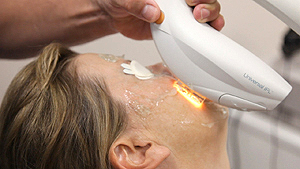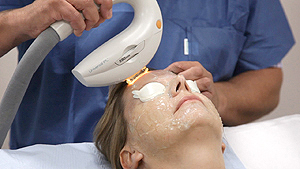At our clinic, we specialise in the latest treatments for removing the tell-tale signs of ageing. This includes the treatment of age-spots and solar lentigines, which are the brown marks that appear on the face, chest and back of the hands. One of the most effective ways to treat this is using an Intense Pulsed Light (IPL) Laser System, which uses laser light to selectively destroy the pigment in the skin. Creams and topical treatments are much less effective as the pigment is distributed too deep within the skin. The laser light is able to penetrate to the correct level and remove the pigment permanently. It can be combined with conventional therapies including dermal fillers and Botox® injections. The treatment can improve skin tone and texture, lift and hydrate skin and even out pigmentation. It makes skin firmer and smoother, reducing lines and wrinkles. It can be used on the face, neck and chest as well as other areas which have been exposed to sun, such as the backs of hands.
How does Intense Pulsed Light Work?
Intense Pulsed Light is a light produced by a flash-lamp in the spectrum of 515-1200nm. The light penetrates deeply into the skin and selectively destroys melanin pigment that is responsible for the brown marks. It also produces Type I collagen synthesis that thickens the skin and helps improve fine lines and wrinkles. Stimulation of the blood supply also helps improve the feel and smoothness of the skin.

What are the side-effects of treatment?
Most patients experience some redness for up to 48 hours following treatment and swelling may also occur. The brown lentigines (sun-spots) will darken for 7-10-days before peeling off. Blistering and crusting of the skin may rarely develop. The risk of scarring is extremely small. It is very important that patients do not have Laser Therapy within 4-weeks of a holiday involving sun-exposure, as melanin pigment in the skin absorbs the laser light and causes a higher risk of side-effects. We are also more cautious with Laser Therapy in darker skinned individuals. We advise using sun-blocks before, during and after treatment for a minimum of 2-weeks. A factor SpF 30 is usually adequate. Typically, 2-4 sessions are required. Darker brown lentigines respond best to treatment compared to light brown ones.
How much does treatment cost?
We charge per session and advise 2-4 sessions at 3-4 weekly intervals for maximum improvement. The treatment can be combined with other treatments including Botox® for wrinkle reduction on the face or Restylane Vital® on the back of the hands.
This treatment is often combined with other treatments available such as Botox™, Restylane™ or Jan Marini™ chemical peels.
What happens during consultation and treatment?
Prior to treatment, you will have a consultation with one of our practitioners to decide which treatment is going to be effective for your skin problem. They will discuss all aspects of the treatment ranging from how it works, how many sessions will be required and what the potential side effects are. Clear and expected treatment expectations will also be discussed. Following your consultation, you will have a patch test on the area to select the correct settings on the laser for your first treatment and to see how your skin reacts to the treatment. Following the patch test, you can start your treatment a few days later.
During treatment, you will lie on the couch with black out goggles on if having facial treatments and non-black out goggles if having hands treated. An intense burst of light is shone on to the skin. No anaesthetic is used. The process can be mildly uncomfortable but is very quick. No recovery time is needed, but the skin may look slightly red. Facial and Hand Skin Rejuvenation treatments are given in courses of 4–6 with a 2-3 week gap between each treatment. To maintain results you will need to have top up treatments a few times a year. These will, of course, vary slightly depending on your skin.
Do different skin types affect the treatment process?
The most difficult skin to treat are patients with Fitzpatrick skin type I as these patients usually have a long history of sun exposure. This skin type is difficult to treat due to the connective tissue being so fragile that the IPL parameters selected may damage the skin. In these cases, low energy settings are used during the early treatments until the supporting dermal connective tissue is strengthened and there has been a reduction in redness. Patients with this skin type usually require additional treatments in comparison with other skin types.
Another problematic skin type is the very dark skin type, particularly Afro-Caribbean, this is due to the high levels of melanin in the epidermis which absorbs light energy in competition with the melanin in the targeted area.
Darker Asian skin which occurs largely in regions of the world that has intense sunlight actually features a naturally high level of epidermal melanin and therefore treatment has to be modified to take this into account.

What pre-treatment precautions must I follow?
With any skin type, the patient must start the IPL treatment without any active suntan and be familiar with following a strict routine, for a minimum of two to four weeks, of using sunscreens and other skin care products recommended for them by their dermatologist.
If this advice is not followed and good skincare practice is not adopted prior to treatment, the outcome of the treatment will be comprised and often short-lived.
